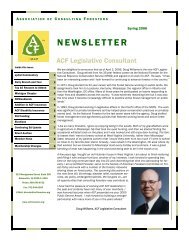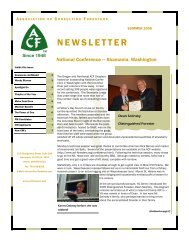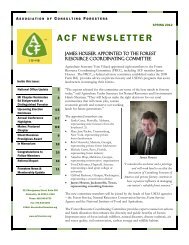Summer 2007 ACF Newsletter - Association of Consulting Foresters ...
Summer 2007 ACF Newsletter - Association of Consulting Foresters ...
Summer 2007 ACF Newsletter - Association of Consulting Foresters ...
You also want an ePaper? Increase the reach of your titles
YUMPU automatically turns print PDFs into web optimized ePapers that Google loves.
Page 6<br />
<strong>ACF</strong> NEWSLETTER<br />
Council <strong>of</strong> Tree and Landscape Appraisers (CTLA)<br />
The Guide for Plant Appraisal<br />
Dick Gooding and Bret Vicary, <strong>ACF</strong><br />
CTLA’s Role in Revising The Guide for Plant Appraisal<br />
The Council <strong>of</strong> Tree and Landscape Appraisers (CTLA) is in the midst <strong>of</strong> revising the Guide for Plant Appraisal. This article discusses<br />
the impetus behind the 10 th edition, highlights some <strong>of</strong> the proposed features <strong>of</strong> the text, and describes the process the<br />
Council is following.<br />
How Did We Get Here<br />
Plant appraisal has come a long way, and so has the Guide for Plant Appraisal. Prior to the 8 th edition (1992), the Guide looked<br />
at trees mainly as things having intrinsic value, more or less independent <strong>of</strong> their contribution to the market value <strong>of</strong> the property<br />
on which they sit. Formulaic approaches were the focus, with attempts to apply standard assigned dollar values per cross sectional<br />
square inch and develop cost-based estimates that would satisfy insurance companies and the courts. Plant appraisers<br />
were “plantsmen”, emphasizing – and in some cases advocating for – intrinsic plant values. After all, plants support the very essence<br />
<strong>of</strong> life, providing humans with oxygen, shade, and other benefits while recycling carbon dioxide and pollutants. Many plant<br />
appraisers have held that these benefits translate directly into “value,” as evidenced by the fact that customers pay real money to<br />
have plants installed.<br />
The real estate industry has enjoyed phenomenal growth since World War II. As people in the United States have become more<br />
prosperous, we have seen rapid growth in the nursery and landscape industry. Plants and outdoor hardscapes now represent a<br />
multi-billion dollar industry, and the need for pr<strong>of</strong>essional plant appraisal services has never been greater.<br />
Why Produce a New Edition<br />
There are three principal reasons for producing the 10 th edition. First, the 9 th edition does not <strong>of</strong>fer satisfactory guidance in problem<br />
identification and solving. Second, the terminology and concepts historically applied are inadequately defined and <strong>of</strong>ten conflict<br />
with terms and concepts promulgated by the real estate appraisal pr<strong>of</strong>ession; there is no legitimate reason for this to remain<br />
the case. Third, the plant appraisal pr<strong>of</strong>ession suffers from a credibility problem arising from two primary sources: unwarranted<br />
advocacy, and practices that are not rooted in economic reality or empirical data.<br />
The IRS does not accept formulaic cost methods to determine appraised values. The courts, while at times recognizing the intrinsic<br />
value <strong>of</strong> trees and shrubs, generally prefer to see actual replacement or restoration costs, and in many cases insist that plant<br />
valuations reflect their contribution to the overall market value <strong>of</strong> the property upon which the plants sit. The 10 th edition will<br />
place more emphasis on these issues.<br />
As noted above, early editions <strong>of</strong> the Guide instructed appraisers to estimate tree value by assigning a dollar value per crosssectional<br />
area. The 9 th edition (2000) began to de-emphasize formulaic solutions, adding more about how plant values are indeed<br />
related to real property value. It reflected an increased emphasis on market value and related concepts. Yet, it remained<br />
overly focused on only one <strong>of</strong> the three basic methods <strong>of</strong> appraisal – the cost approach – while giving short shrift to the sales<br />
comparison (market) and income approaches. Moreover, it has been criticized by many users for not providing clear guidance to<br />
appraisers in defining the nature <strong>of</strong> the appraisal problem and determining which methodology is best to apply. A “guide” should<br />
guide! It should provide sufficient detail to enable the appraiser to follow a systematic process for defining the appraisal problem,<br />
identifying the proper appraisal approach, and developing a credible conclusion.<br />
What Will the 10 th Edition Look Like<br />
The Council expects the 10 th edition to reflect a significant point <strong>of</strong> departure from past editions. It will discuss plant appraisal in<br />
relation to real property appraisal, highlighting where the two pr<strong>of</strong>essions intersect and where they depart from one another.<br />
Where terminology between these two pr<strong>of</strong>essions differs, we will <strong>of</strong>fer suggestions for reconciling terms so as to mitigate confusion<br />
and progress toward a more common language.<br />
The Internal Revenue Service and some courts have rejected traditional cost approach methods that are the primary focus <strong>of</strong> the<br />
9th edition. The Council therefore will strive to provide more balance to the text and advance ideas more consistent with principles<br />
<strong>of</strong> real property appraisal. We will clarify where cost methods may be appropriate, and how to tie them into market value if<br />
(Continued on page 7)





